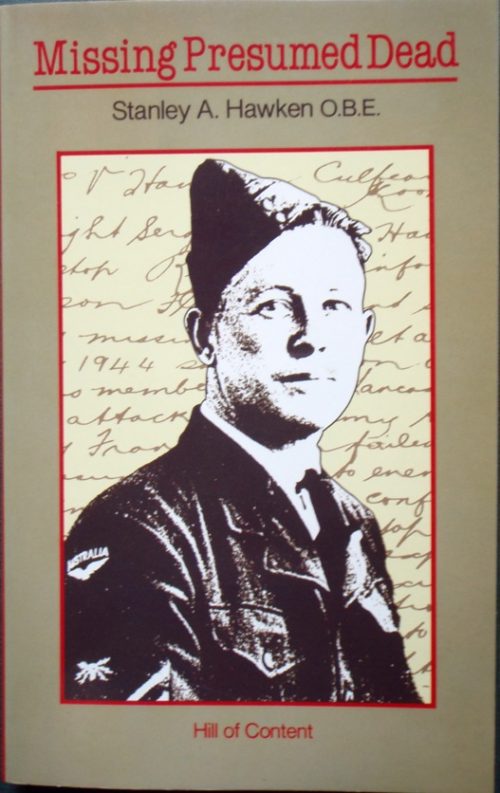Description
Title: Missing Presumed Dead
Author: Hawken, Stanley OBE
Condition: Near Mint
Edition: 1st Edition
Publication Date: 1989
ISBN: 0855721855
Cover: Soft Cover without Dust Jacket – 209 pages
Comments: The fascinating biography of Stanley Hawken OBE and his experiences during World War II.
The author flew as an RAAF Wireless operator and Air Gunner in Lancaster heavy bombers in World War Two and was later shot down and became involved with the French resistance.
It was after enlisting in the Royal Australian Air Force (RAAF) in 1941 that Stan Hawken’s life dramatically changed. As he commented, his air force career broadened his horizons and provided better prospects for improving himself when he returned to civilian life. Nevertheless, because of his lack of educational qualifications he had to argue strongly before an interview panel that he was a suitable candidate for air crew training. He must have done it well because he was successful. After extensive training at various air bases in Australia he qualified as a wireless air gunner and was posted to England.
Following a six week journey starting in Sydney, crossing the Pacific in an American troop ship, a train journey across the American continent in a Pullman train coach with all amenities including porters to look after personal comforts, an idyllic stay in Boston, New England, an uneventful voyage across the Atlantic in the Queen Elizabeth which was transporting more than 18,000 American soldiers in cramped conditions, and a train trip from Glasgow Scotland , Stan Hawken arrived in Brighton on the south coast of England. There further training began.
It was at several English bases that the work began to fit the Australian and other volunteers for operational flying. European climatic conditions were very much different from those experienced in Australia and it took a great deal of adjustment by individuals to cope. This adjustment was in addition to what crews needed to do to accommodate to pressures experienced in action.
Stan Hawken joined the crew of P-Peter. As well as Stan the team was made up of two Australians, two Londoners, a Scotsman and a Rhodesian. Stan said the crew worked hard to improve their performance but when the opportunities presented themselves, ‘played hard’. Although he insisted, drinking was completely out on any day they were rostered for flying.
P-Peter was part of 630 Squadron formed on November 19, 1943 and part of Bomber Command. The squadron exclusively flew Lancaster Bombers from Lincolnshire and by the end of the war had flown 2453 sorties and lost 59 aircraft with an additional 11 destroyed in crashes. The first action raid of P-Peter was to a military camp in Belgium at Bourg-Leopold where success would have significantly disrupted the German war effort.
On arrival P-Peter found the target covered by thick cloud so eventually the attack was aborted thus averting the possibility of collision amongst the 190 Lancasters and eleven Mosquito bombers included in the raid. Later sorties had great military success although the threat of attack from German fighter planes and flack from anti aircraft guns persisted.
Stan Hawken and his fellow crew members had made fifteen trips, were half way to achieving the goal of surviving a ‘tour’ of thirty trips when they were rostered to join an attack on Revigny, a railway marshalling yard 225 kilometres east of Paris, on July 19, 1944. On this occasion the luck of P-Peter ran out. Of a force of 115 aircraft, 21 were lost during 5 ½ hour’s flying time. P-Peter was one.
Stan Hawken recalled they ran into a hornets’ nest of German fighters. The enemy had guessed their intended target and were waiting. The danger was increased when Bomber Command ordered the attacking force to delay their bombing run by five minutes. During this delay his plane was struck by a short burst of bullets. But it was enough to cripple the aircraft. The two inboard engines burst into flames and were burning out of control when the order was given to ‘bale out’. Later Stan learned that four of the crew had failed to escape the crippled aircraft and died when the plane exploded. However, he and two gunners parachuted successfully to the ground.
On landing in a small forest Hawken crashed into a tree knocking himself out. After gaining consciousness, disposing of his chute, walking some distance, moving around a village to avoid detection, getting a few hours sleep in a wood and observing a farm house for some time, he approached the occupier and asked for help. A small boy summoned the village school teacher, Jean Vidal, who took Stan back to his house where his wife provided the first food Stan had had in two days; chicken soup, chicken and vegetables finished off with steamed pudding; a veritable feast in food starved France.





